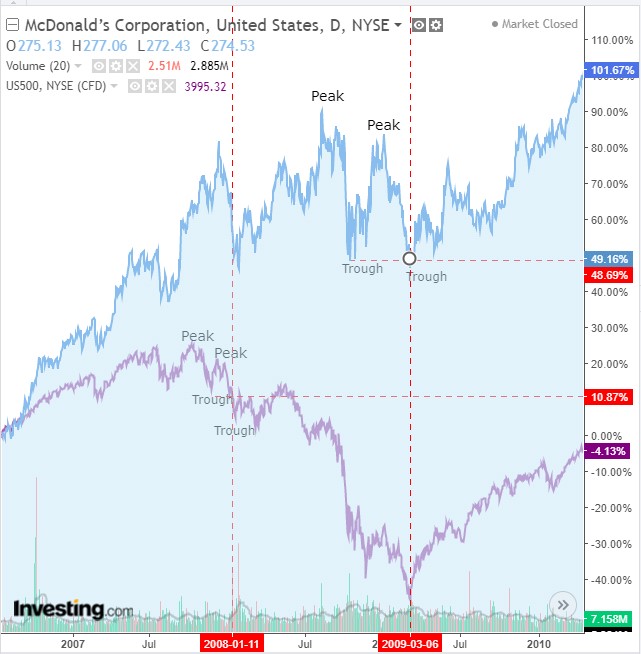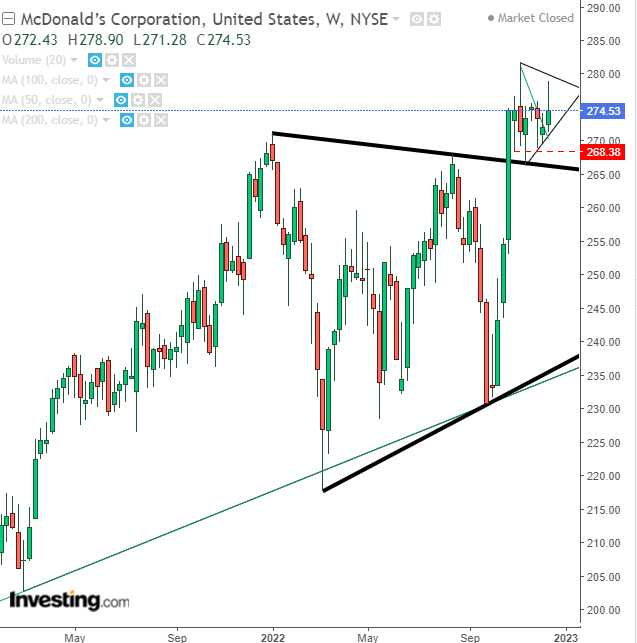- McDonald's reported a 9.5% increase in same-store sales for the latest quarter
- The global giant keeps meals affordable to attract consumers while costs rise
- Here is how to trade the stock
- Entry: $272
- Stop-Loss: $270
- Risk: $2
- Target: $278
- Reward: $6
- Risk-Reward Ratio: 1:3
- Entry: $280
- Stop-Loss: $275
- Risk: $5
- Target: $295
- Reward: $15
- Risk-Reward Ratio: 1:3
McDonald’s (NYSE:MCD) reported a 9.5% increase in same-store sales for the latest quarter compared to last year's period. The company's CEO, Chris Kempczinski, said that the company is expecting costs for food, materials, and labor to rise in the coming year and is bracing for a potential economic downturn in the US and Europe.
Kempczinski added that McDonald's plans for a mild to moderate US recession and a potentially more profound and longer downturn in Europe, as the company sees consumer sentiment in the old continent remaining low.
McDonald's also informed that it experienced challenges in China due to renewed government COVID-19 restrictions. Despite this, the company said that its business was strong overall. McDonald's expects to keep its meals affordable relative to competitors to continue attracting consumers.
Marketing, featuring its core menu, helped generate sales and more orders in the US during the latest quarter. The chain's Cactus Plant Flea Market Box, a Happy Meal geared toward adults, was also successful, with half of the toys selling out within days of its debut.
McDonald's thrived during the 2007-9 global recession, with solid sales and stock performance.
One reason for this success is the company's positioning as a cheap and convenient option for consumers trading down in a recession.
Another reason is the company's unique business model, which focuses on real estate ownership. McDonald's is one of the world's largest real estate holders, owning most of its locations and leasing them to franchisees at above-market rates. This hidden source of income allows the company to generate significant revenue from rents in addition to sales of its products.

The S&P 500 index entered a downtrend when posting a descending series of peaks and troughs on Jan. 2008, but McDonald's never registered two falling peaks and troughs. So, the stock never technically entered a downtrend.
When comparing two charts, the software shows the second asset in a line chart. For the sake of comparison, I also showed McDonald's in a line chart.
In this format, the stock briefly posted the second declining trough, establishing a downtrend in Mar. 2009, when the market rebounded. However, the correct chart drawing includes intraday prices, and MCD never posted a second lower trough.

The stock forms a symmetrical triangle, a range in which bulls and bears are equally eager. You know why there is demand after reading the above, but why would there be supply? You might be asking yourself.
Because some investors believe the stock is pricey. It's impressive that the company's up 2.4% YTD, when the S&P 500 is 17% lower, and that the stock is 2.6% from its Nov. 10 all-time high, and yesterday it came within 0.63% of that level. Conversely, by definition, that means the stock is expensive.
However, if the price breaks to the topside, as I expect it to, it will demonstrate that demand is overcoming supply. I'll also explain why I don't think the price completed a pennant (green line) because (1) the price almost went to the apex, suggesting no clear victory to one side, (2) it did so with a flat move, perpetuating the same indecision and (3) no spike in volume, again, demonstrating no shift in the supply-demand balance.
So, why do I expect the pattern to break to the topside?
First, while its symmetry projects an equilibrium, it developed amid an uptrend. So, once profit-taking is done, the trend tends to persist. Now, let's look at the bigger picture.

The triangle has been forming on top of the range since the first half of 2021. That development within the context of the recession prompted me to post precisely one month ago a bullish call with a $320 target. Here is an earlier bullish call, based on selecting which technicals I want to trust over others, which I considered within a broader market scope.
Trading Strategies - Long Position Setup
Conservative traders should wait for the triangle to complete, with a 3% breakout on a closing basis, then wait for a pullback to find support above the pattern, which should lease three days from the breakout.
Moderate traders would wait for two-day, 2% penetration on an intraday basis. Alternatively, they could buy upon confirmation of support at the bottom of the pattern, then wait for the price to retest the bottom to allow a close entry, increasing the reward to the top and reducing the exposure to the bottom.
Aggressive traders could go long with a one-day, 1% upside breakout, or if the price retests the pattern bottom.
Trade Sample 1: Retesting Bottom - Aggressive Long
Trade Sample 2: Upside Breakout - Aggressive Long
Disclosure: The author does not own any of the securities mentioned in this article.
